Dolores Hidalgo: A trip back in time to be filled with history… and its wines.
News Category: News, General Discussion, and Travel
-
Dolores Hidalgo, the first Magical Town of the State of Guanajuato is where great stories originated, here began the national Independence movement, and where one of the most internationally recognized Mexican singers, José Alfredo Jiménez, was born.
Cradle of the National Independence, fertile land that engendered the vine and turned it into vineyards, Dolores Hidalgo is a Magical Town that radiates charm and history within its walls and offers a diversity of handicrafts in Talavera and ceramics.
It is a joy to visit its museums, monuments, exhaciendas, and temples and a delight to enjoy its handcrafted gastronomy and its traditional ice creams with unique and exotic flavors.
Among the 46 municipalities of Guanajuato, Dolores Hidalgo could be the one that saw the most struggles and dreams, from its beginning as “Cocomacán” which means a place where turtledoves are hunted, and for its past in the conquest and proclamation for the autonomy of a nation until it was consecrated as the medullar point where it began to write what is now Mexico.
Dolores Hidalgo has an important historical heritage that is shown in its streets and squares, it has emblematic sites such as the Parish of Nuestra Señora de Los Dolores, the Casa de Visitas, and the Casa de Abasolo which became a museum during the celebrations of the Bicentennial of the National Independence Struggle.

Nuestra Señora de los Dolores Parish Church
Before the cry for Independence was given, almost a century ago, the first stone of the “Iglesia de Dolores” was laid, which took almost 70 years to be built, it is an architectural sample of the baroque but it was a heroic scene in this place the priest Miguel Hidalgo y Costilla gave the Cry of Dolores with which the Mexican War of Independence began.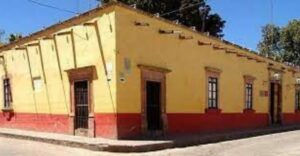
Hidalgo House Museum
Miguel Hidalgo lived in this old mansion during his time in Dolores, he lived there until 1810 when it was still known as the Casa del Diezmo and during the Independence struggle, it passed into the hands of different sides.The property in those years was stripped of objects that now would have an incalculable value but it never lost the charm that remains today for the enjoyment of those who visit it.
It took a long time for the property to be rescued, first by Benito Juarez who declared it a National Monument in 1863, and in 1946 it became a museum.
Among its other items, it has a priestly vestment, some glasses, and a holy water dispenser that belonged to Miguel Hidalgo. Even the skeleton of General Pedro Garcia, who faced American and French troops, participated in the War of Independence and guarded the museum until his death.

Bicentennial Museum (Casa de Abasolo)
This place has more than 800 pieces allusive to the celebration of the first centennial of the Independence as portraits, photos of buildings, music, weapons, and jewelry of the time.It is divided into five rooms where you can discover what life was like during the Porfiriato period, the life and customs of Mexico, and Guanajuato at the beginning of the 20th century.
Among the memorabilia of the Independence Centennial, are the invitation program to the celebrations, the lavish menu that Porfirio Diaz proposed and there is even a conversation he had with the American scientist Thomas Alva Edison, subtitled from English to Spanish.
There are also cigarette packs, matches, knives, cutlery, and more than a hundred photographs with images of the Industrial Revolution and post-revolutionary Mexico belonging to the Alhóndiga de photo library Granaditas.
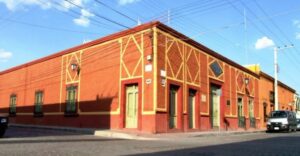
José Alfredo Jiménez Museum
The house where José Alfredo Jiménez, born in Dolores Hidalgo, lived became a museum that houses records, hats, charro suits, lyrics in his handwriting, and a chronology that visually narrates life of the Mexican singer-songwriter.The different rooms show his childhood, his approach to music, his first presentations, and the arrival of his first wife Paloma Gálvez, an undeniable muse of his most beloved songs.
There is also a reminder of his last live performance and the emergence of the legend that, through his profound lyrics, impacted Mexican music and culture and turned him into an idol.
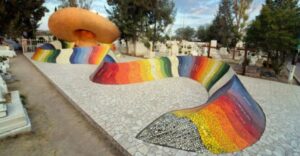
José Alfredo Jiménez Mausoleum
The resting place in Dolores Hidalgo of José Alfredo Jiménez is perhaps the most visited in a cemetery in Guanajuato, it is a mausoleum that breaks with everything seen. The vivid colors of a long snake-shaped sarape are joined by a huge charro hat that shades the eternal abode of “El Rey” as he was also called.José Alfredo asked for his tomb to be nothing more than a simple tombstone and so it was, but the town and his relatives asked that as a tribute he be given a post-mortem gift, which would also serve for visitors to find where his remains rest and this striking mausoleum was installed on the occasion of the 25th anniversary of his death.
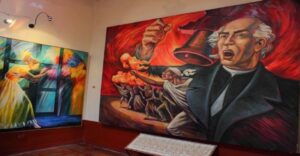
Independence Museum
When visiting Dolores Hidalgo you should also visit the Museum of Independence, a place that was a prison in the 18th century, and here were kept prisoners who joined the Independence struggle led by Miguel Hidalgo y Costilla.From this site, Miguel Hidalgo, after crying for independence, freed all the prisoners in the early morning of Sunday, September 16.
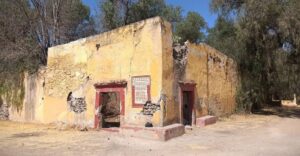
Hacienda de La Erre
On September 16, 1810, at noon, the priest Miguel Hidalgo y Costilla arrived at this hacienda and ate in the farm’s living room.
Finished the meal and after having formed the first staff of the Insurgent Army, he gave the order to march towards Atotonilco, and in doing so he said:“Come on, gentlemen, let’s go; the cat’s bell has already been rattled, it remains to be seen who are the ones we have left over.”

Wine Museum
Guanajuato has fertile soil and Miguel Hidalgo y Costilla knew this in the early 19th century, so he planted vines and taught the people of Dolores how to make wine.Dolores Hidalgo has the Wine Museum, the second museum exclusively dedicated to winemaking in Mexico and you can also tour the beautiful vineyards that are located on the outskirts of the city.
There are vineyards where the bunches are cleaned by hand before being crushed; cold maceration is practiced to allow the grapes to release their subtle aromas; and once the wine is turned, it is left to rest in French, Hungarian, and American oak barrels.
The Wine Museum occupies what at the beginning of the 20th century was the Dolores Hidalgo Hospital, which is more than 230 years old, and next to it is the house where the priest Miguel Hidalgo y Costilla lived.
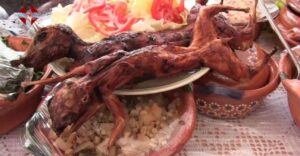
Gastronomy, a delight to the palate
Dolores Hidalgo offers a diverse Otomi gastronomy with typical dishes such as magueyera rat broth, rabbit broth, chapulines, chiles stuffed with huitlacoche, squash blossom, gorditas, tantarrias, bean soup, corn soup, orejones, pumpkin flower stuffed cakes, potato cakes, spinach, qualities, gorditas al comal and different stews.You can also taste atole de cascara, mesquite, agua de borrachita, garambullo, alfalfa, cucumber, chia, lemon, among other flavors and desserts such as gorditas de trigo, de nata, de horno made with piloncillo and cinnamon, buñuelos, garapiñados, pepitas garapiñada, quince jams, peach, prickly pear, pinole and much more.
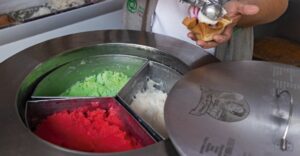
Traditional and exotic ice creams
Dolores Hidalgo offers a great variety of ice cream flavors and in some ways even exotic ones since dishes and ingredients such as mole, chicharron and avocado have been turned into ice cream sold in the Main Square to the delight of travelers.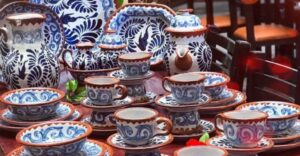
Handicrafts
In Dolores Hidalgo, the handicrafts stand out for being unique expressions such as Talavera or Mayolica ceramics, which are techniques of great vivid colors that keep alive a centuries-old tradition.Dolores Hidalgo lacks nothing, with so many museums, restaurants, and cantinas, it will be difficult to decide where to start touring it and it has places to rest, it has hotels with a lot of history, such as the Posada Cocomacán, which hosted Benito Juárez when he returned from the north of the country.
To get to Dolores Hidalgo by car will take 45 minutes from San Miguel de Allende (45 kilometers), from Guanajuato capital, it will take one hour (60 km) and if it is from Mexico City it will take 4 hours, and 15 minutes to get there (320 km).
-

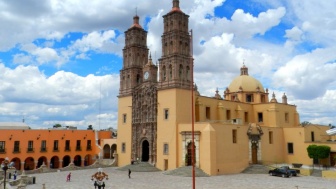
Leave a Reply